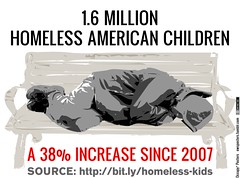There were 1,065,794 homeless students in the U.S. in June 2011, The U.S. Education Department estimates. Recent data show that the number of homeless students rose in 44 states, and that 15 states saw increases of 20% or more. Kentucky had a 57% rise in homeless students over one year. The U.S. homeless student count rose 57% since the start of the recent recession, in 2007.
Prominent homelessness expert Diana Nilan (who once was homeless herself) says:
The government estimate of over a million homeless students is horrifyingly high, but it probably is half of what it would be if all the kids were counted. The count doesn’t include homeless infants, children not enrolled in school and homeless students that schools simply failed to identify.
Seventy-one percent of the kids identified as homeless by the Education Department listed the homes of family or friends as their primary residence, but these kids aren’t counted as homeless by the U.S. Department of Housing and Urban Development, which means they can’t apply for subsidized housing. That’s bogus!
Many parents fear losing custody of their children who sleep on the street, so they seek alternative living situations (such as in motels, sleeping on friends’ couches and moving around a lot). Efforts are underway in Congress to pass HR 32, which would broaden HUD’s current very-narrow definition of homeless children (those on the streets and in shelters only) and permit more of them to receive government assistance.
A new report shows that only 52% of homeless students who took standardized tests were proficient in reading and only 51% were in math. In Virginia, 21.2% of students who are homeless at some point during their high school years drop out, compared with 14.8% of all poor children. In Colorado, the high school graduation rate is 72% for all students, 59% for poor students and 48% for homeless students,
“When “you don’t have a permanent place to stay, you have to change schools a lot,” said Barbara Duffield, policy director for the National Association for the Education of Homeless Children and Youth. “It sets you far behind and is socially and emotionally disruptive.”
When Sherrie Gahn became principal of Whitney Elementary in Las Vegas, she was shocked to find students eating ketchup from packets and learned that 85% of them were homeless.
So she told parents:
Give me your children and let me teach them, and in turn I will give you food and clothes and we will take them to the eye doctor. I will pay your rent and your utilities, but you must keep your child here.
Funded by organizations and private donors, she meets a wide range of homeless student needs, from haircuts to financial assistance—and as a result those kids have doubled their standardized test scores. She is now working with Nevada’s First Lady, Kathleen Sandoval, to create an after-school program that will make the children feel productive. Gahn has also promised her homeless students that if they graduate from high school and cannot afford college, she will help pay their tuition.
In Minnesota, where 9% of students were homeless last year (and at least one was regularly sleeping in a public toilet), the legislature is considering a $50 million boost in homelessness programs, plus $50 million in bonding for affordable housing. Last year the state spent $8 million transporting homeless students.
In Pittsburgh, between 2005 and 2009, black homeless families made up 56.3% of residents in family homeless shelters, even though they only accounted for 12 %of the city’s population. Educational disparity is one major reason. So after-school programs are being introduced in homeless shelters.























